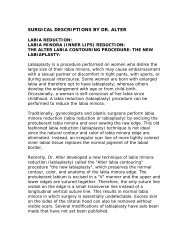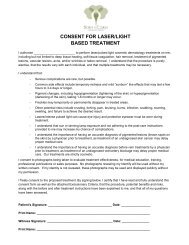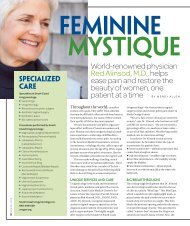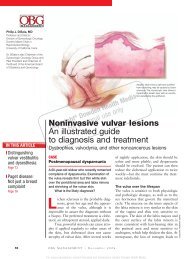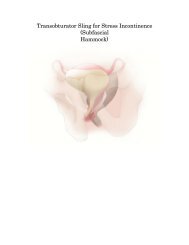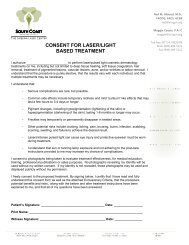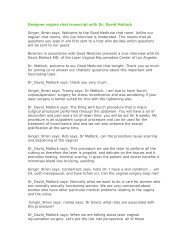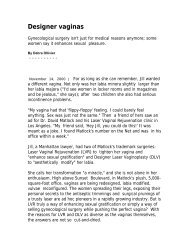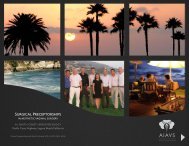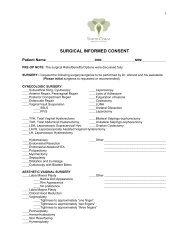Lux 1540 Fractional Handpiece Refines Skin Resurfacing - Urogyn.org
Lux 1540 Fractional Handpiece Refines Skin Resurfacing - Urogyn.org
Lux 1540 Fractional Handpiece Refines Skin Resurfacing - Urogyn.org
- No tags were found...
You also want an ePaper? Increase the reach of your titles
YUMPU automatically turns print PDFs into web optimized ePapers that Google loves.
AestheticBuyers Guide®The Leading Aesthetic Practice Resource <strong>Lux</strong><strong>1540</strong> <strong>Fractional</strong> <strong>Handpiece</strong><strong>Refines</strong> <strong>Skin</strong> <strong>Resurfacing</strong>The patented fractional resurfacing capability of the <strong>Lux</strong><strong>1540</strong><strong>Fractional</strong> laser handpiece from Palomar Medical Technologies, Inc.(Burlington, Mass.) has greatly improved skin resurfacing, according to clinicalresearchers. This new handpiece, which is an attachment to the PalomarStar<strong>Lux</strong> ® pulsed light and laser system, delivers light in an array of high precisionmicrobeams. These microbeams create narrow, deep columns of tissuecoagulation that penetrate through the epidermis and into the dermis, whilesparing the tissue surrounding the columns from damage.“In my opinion, fractional resurfacing has proven to be the goldstandard for the treatment of many skin conditions. This includes finerhytides, acne scars and melasma,” said Vic Narurkar, M.D., a dermatologistin private practice in SanFrancisco, Calif. “In fact, in my practice,fractional resurfacing has virtuallyreplaced ablative resurfacingbecause we are achieving consistentresults, without all the risks associatedwith ablative procedures, assumingthere is proper patient selection.”Forehead before TxForehead after two <strong>Lux</strong><strong>1540</strong><strong>Fractional</strong> treatmentsThe <strong>Lux</strong><strong>1540</strong> handpiece easily integrateswith the other elements of theStar<strong>Lux</strong> platform. “This includes the<strong>Lux</strong>G green light handpiece, whichhas been my workhorse for performingphotorejuvenation,” noted Dr. Narurkar,who often schedules blending treatments.For instance, he may use thegreen handpiece on telangiectasis orlentigines, then use the <strong>Lux</strong><strong>1540</strong> handpiecefor rhytides.Dr. Narurkar is currently involvedin clinical trials assessing the efficacyof the <strong>Lux</strong><strong>1540</strong> handpiece in combination with the <strong>Lux</strong>G handpiece. “Ifsomeone has more superficial damage, such as telangiectasis or lentigines,we address that with the <strong>Lux</strong>G handpiece. But when you need to go deeperfor resurfacing or for rhytides or acne scars, you can use the <strong>1540</strong> nmhandpiece. We now have a platform that allows us to change handpieces toaddress the different etiologies.”September / October 2006Circulation: 18,000Allergan Corporate Profile.........10Cutera’s Laser Genesis.............16Vivelif Wrinkle Serum ................21Gemini Vascular Tx ...................26Omnilux Clinical Roundtable .....32SeSDERMA’s Pyruvic Peel .......38LumiPhase Enhances PDT .......64Controversies Symposium ........72Radiesse Roundtable...........InsertBruce Cunningham, M.D.ASPS ShowPreview..................Page 50www.miinews.comPRSRT STDU.S. POSTAGE PAIDPERMIT NO. 1269LONG BEACH, CAcontinued on page 4
continued from page 1When using the <strong>Lux</strong><strong>1540</strong> handpiece, Dr. Narurkartypically overlaps pulses and performs two to threepasses. “I usually do about a 2 cm x 2 cm area, then goon to the next 2 cm x 2 cm area, with a 50% overlap.This is more comfortable to the patient because multiplepasses build up heat and discomfort increases. Byoverlapping, you give the skin a chance to relax beforemoving on to the other element of the skin.”“I’m most impressed with the ease of application tothe patient’s skin compared to other fractionaldevices,” said Robert Weiss, M.D., an associate professorof dermatology at Johns Hopkins University Schoolof Medicine in Baltimore, Md. “There is no messy bluedye and most patients can be treated without topicalanesthetic. There is also no cost of disposables.”The predictability of an array of microthermalzones rather than an irregular scan is another advantageof the <strong>Lux</strong><strong>1540</strong> handpiece. “This leads to much lesspatient discomfort because heat is distributed moreevenly,” Dr. Weiss said. “There should also be increasedefficacy compared to other mid 1500 nm devices.”Robert Weiss, M.D.Associate Professor of DermatologyJohns Hopkins University School of MedicineHunt Valley, MDDr. Weiss and his associates are conducting a clinicaltrial for Palomar for treating acne scars and wrinkleswith the <strong>Lux</strong><strong>1540</strong> handpiece. The treatment protocolis the same for both indications: three sessions,one month apart. “For acne scars, we are seeing significantimprovement. The improvement in wrinkling hasalso been significant. Patients are very pleased. Thehandpiece allows you to treat right up to the lower eyelidfor wrinkles under the eye. This is very difficult toaccomplish with scanning fractional technology.” Dr.Weiss also finds it very easy to do complete coverage ofthe skin. “You can readily see the treated areas becauseof the slight redness, so there are no skipped areas.”The <strong>Lux</strong><strong>1540</strong> handpiece protects the skin by deliveringmicrobeams in individual short pulses, withactive contact cooling.Furthermore, the handpiece features two heads fordifferent treatment approaches. The 10 mm spot sizehead delivers fluences up to 100 mJ per microbeam(mB) and creates a 100 mB/cm 2 array of columns fordeep coagulation. In contrast, the 15 mm spot size headdelivers fluences up to 15 mJ/mB and creates a 320Before TxAfter <strong>Lux</strong><strong>1540</strong> <strong>Fractional</strong> TxmB/cm 2 array of narrow columns for relatively shallowcoagulation.“In the study, we are only using the 10 mm spot,”Dr. Weiss explained. “However, we anticipate treatmentwith the 15 mm spot for patients with moresuperficial wrinkles or scars. Overall, I think it isremarkable that one platform can offer so many choices.You should be able to treat virtually any cosmeticskin problem. <strong>Fractional</strong> technology also allows you totreat all skin types, even up to Fitzpatrick skin type VI,and patient discomfort is minimal.”“It’s wonderful to be able to treat some cosmeticindications that traditionally I’ve had to treat withablative technology,” added E. Victor Ross, M.D., directorof the Laser and Cosmetic Dermatology Center atScripps Clinic in San Diego, Calif. “For example, withacne scarring, I previously needed to use an ablativetechnology or something invasive to end up with anyreal improvement. There was nothing available thatwould return the patient back to normal within one orE. Victor Ross, M.D.Director of the Laser and Cosmetic Dermatology Center atScripps ClinicSan Diego, CAtwo days.” Similarly, when treating wrinkles, “witholder technology, the patient might have been down for5, 7 or 12 days. With the <strong>Lux</strong><strong>1540</strong> handpiece, thepatient is swollen for only one or two days and hasminimal downtime.”As of the middle of August, Dr. Ross had treatedabout 25 patients with the handpiece. “Acne scarring ismy primary indication. I schedule four sessions aboutthree to four weeks apart. Patients can expect 30% to50% improvement in particular types of scars, such assubtle boxcar scars and some small rolling type scars.4Aesthetic Buyers Guide September/October 2006 www.miinews.com
Modest scarring responds reasonably well. Results arealso fairly predictable in the patients I’ve treated,which was not the case with other non-ablative technologieslike the 1450 nm laser.” A full face takes about45 minutes.Dr. Ross has also had success in restoring somenormal tone and smoothness of the face, as well as theneck, chest and arms. “When you treat off-face, ablativetechnologies are not very effective. In the past, we’vebeen limited to intense pulsed light (IPL), which isvery nice for pigment. But the <strong>Lux</strong><strong>1540</strong> handpiece canalso improve some of the fine textural changes andthat crepe paper change on the damaged neck, chestand arms.” Treatment for off-face may consist of up tosix sessions, spaced about two to three weeks apart.“Most patients require a numbing cream one hourbefore, which makes treatment much more tolerable. Ialso think that when using this handpiece for any indication,you should lay down as many pulses as thepatient can tolerate. The more aggressive you are, themore robust the results.”On the other hand, the rate of coverage with the10 mm spot size head is slightly slower than with the15 mm spot. “But you can actually move faster with the10 mm spot, so the rate of coverage is not that dissimilarbetween the two,” Dr. Ross said. “The 15 mm<strong>Lux</strong><strong>1540</strong><strong>Fractional</strong>treatmentspot penetrates less and is more geared for superficialpigmentation problems, whereas the smaller 10 mmspot penetrates deeper and is probably better for acnescars and wrinkles.”Stanley Kovak, M.D., who practices cosmetic medicinein the Chicago area, noted that the <strong>1540</strong> nmwavelength “has been shown to allow good penetrationand heats up water well, so you can create an injurypattern in the dermis, thereby causing collagen tobuild up in the area that has been injured.” Dr. Kovakhas recently switched from an older fractional technology,since the <strong>Lux</strong><strong>1540</strong> allows him to denature deepertissue with higher fluence for wrinkles and acne scars.As with Dr. Ross, acne scarring is Dr. Kovak’s mostpopular indication to treat with the <strong>Lux</strong><strong>1540</strong> handpiece.“We typically schedule four to six sessions,depending on the severity of the acne scars, at abouttwo week intervals. Often, we see at least 50%improvement at three to four months after completionof a series.” For any indication, Dr. Kovak prefers totreat with a 40% to 50% overlap. “I treat small sectionsat a time, such as a 5 - 6 cm 2 area. By doing a small sectionat a time, we’re able to sort of circumvent the factthat edema causes less penetration of the wavelength.”The Star<strong>Lux</strong> pulsed light and laser system alsooffers pulsed light and laser handpieces for such applicationsas permanent hair reduction, photofacials forpigmented and vascular lesions, skin tighteningthrough soft tissue coagulation, leg vein treatment andacne clearance. “We combine treatments,” Dr. Kovaksaid. “For instance, we’ll first treat telangiectasis orerythema or even lentigines with IPL, followed by the<strong>Lux</strong><strong>1540</strong> handpiece for wrinkles.”“There is a lot of confusion about what fractionalresurfacing really involves,” concluded Dr. Narurkar, anassistant clinical professor of dermatology at theUniversity of California, Davis. “You really need to be inthe mid-infrared wavelength range – between about1500 nm and 1800 nm – to truly perform fractionalresurfacing. Wavelengths of the CO 2or the erbium 2940laser are too superficial and do not address what we aretying to achieve, which is dermal remodeling of collagen.These other lasers do not penetrate deep enough. The<strong>1540</strong> nm wavelength is ideal for fractional resurfacingbecause it penetrates to the appropriate depth.” ■Editor’s Note: The Palomar <strong>Lux</strong><strong>1540</strong> <strong>Fractional</strong><strong>Handpiece</strong> is FDA cleared for soft tissue coagulation. A510k application has been submitted to the FDA forskin resurfacing.Aesthetic Buyers Guide September/October 2006 www.miinews.com 5




